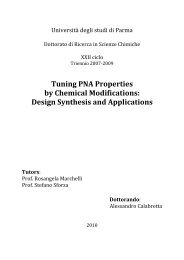You also want an ePaper? Increase the reach of your titles
YUMPU automatically turns print PDFs into web optimized ePapers that Google loves.
CHEST Original Research<br />
Exhaled Metallic Elements and Serum<br />
Pneumoproteins in Asymptomatic<br />
Smokers and Patients With COPD or<br />
Asthma*<br />
Antonio Mutti, MD; Massimo Corradi, MD; Matteo Goldoni, Phys;<br />
Maria Vittoria Vettori, PhD; Alfred Bernard, PhD; and Pietro Apostoli, MD<br />
Study objectives: The aim of this study was to characterize the elemental composition of exhaled<br />
breath condensate (EBC) in order to identify new biomarkers of exposure and susceptibility in<br />
COPD patients. Serum pneumoproteins were used as lung-specific biomarkers of effect.<br />
Design: EBC was obtained from 50 healthy subjects, 30 healthy smokers, 30 asthmatics, and 50<br />
patients with stable COPD, and was collected by cooling exhaled air. Trace elements and toxic<br />
metals in the samples were measured by means of inductively coupled plasma-mass spectrometry<br />
and electrothermal atomic absorption spectroscopy. The serum pneumoproteins were immunoassayed.<br />
Results: The EBC of COPD subjects had higher levels of such toxic elements as lead, cadmium,<br />
and aluminum, and lower levels of iron and copper, than that of the nonsmoking control subjects.<br />
There were no between-group differences in surfactant protein (SP)-A and SP-B levels. Clara-cell<br />
protein and SP-D levels were negatively and positively influenced, respectively, by tobacco<br />
smoke.<br />
Conclusions: Our results show that toxic metals and transition elements are detectable in the EBC<br />
of studied subjects. We propose new biomarkers of exposure as a means of assessing the target<br />
tissue dose of carcinogenic and pneumotoxic substances from tobacco smoke or polluted<br />
workplaces, and the use of the transition elements involved in redox systems of oxidative stress as<br />
disease biomarkers associated with effect or susceptibility. Together with biomarkers of effect,<br />
such as serum pneumoproteins, the elemental composition of EBC may be clinically useful in<br />
distinguishing similar diseases. (CHEST 2006; 129:1288–1297)<br />
Key words: COPD; exhaled breath condensate; metals; pneumoproteins; trace elements<br />
Abbreviations: ANOVA analysis of variance; CC16 Clara-cell secretary protein; EBC exhaled breath condensate;<br />
ETAAS electrothermal atomic absorption spectroscopy; ICP-MS inductively coupled plasma-mass spectrometry;<br />
LOD limit of detection; PM particulate matter; SOD superoxide dismutase; SP surfactant protein<br />
COPD is one of the leading causes of morbidity<br />
and mortality worldwide, and represents a substantial<br />
economic burden on global health. 1 It is<br />
characterized by small airways disease, mucus hypersecretion,<br />
and chronic bronchitis, which lead to an<br />
obstructed airflow that impairs ventilatory capacity<br />
and gas exchange, and causes shortness of breath. 1<br />
Various instruments have been developed for diagnosing,<br />
monitoring, and evaluating COPD. Lung<br />
function tests offer insights into changes in airway<br />
caliber, exhaled air flow, lung volumes, and gas<br />
exchange, 2 and imaging techniques (especially highresolution<br />
CT) offer insight into the loss of lung<br />
COPD<br />
tissue 3 ; both provide indirect measurements of the<br />
adverse effects occurring in a biological system as a<br />
consequence of exposure to toxic or noxious agents.<br />
More direct evaluation of biological lung events can<br />
be obtained using more or less invasive measurements<br />
(bronchoscopy, induced sputum). These have<br />
improved our understanding of the biological processes<br />
occurring in lung diseases and still represent<br />
the “gold standard” for evaluating the diseases themselves,<br />
4 but their applicability is limited mainly because<br />
the invasiveness of the sampling procedures<br />
makes them unsuitable for routine clinical use.<br />
Modern research relies on biomarkers, which are<br />
1288 Original Research<br />
Downloaded from<br />
chestjournals.org on May 23, 2007<br />
Copyright © 2006 by American College of Chest Physicians
















